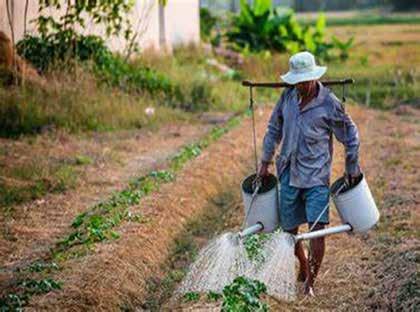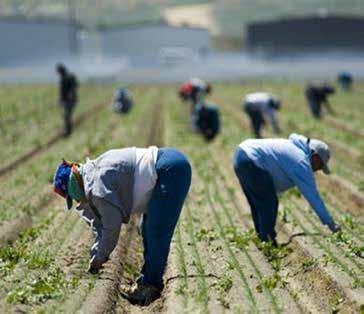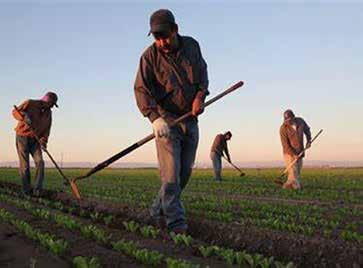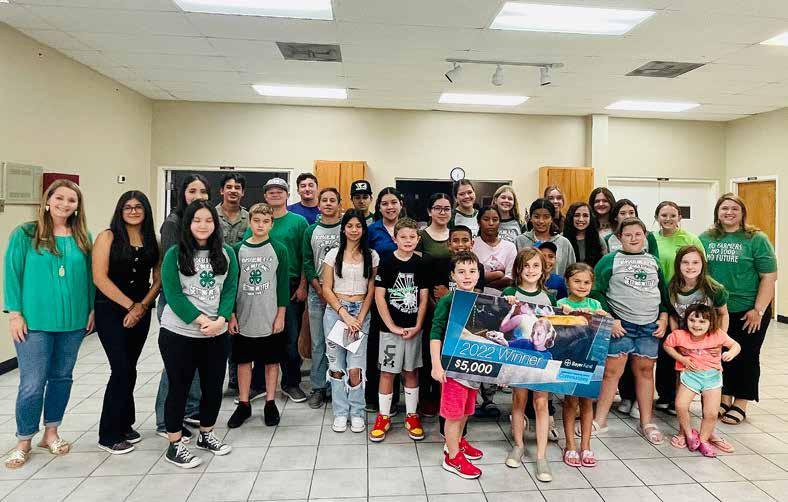
8 minute read
Ag Labor: Changing Perception Means
by THEAGMAG
Ag Labor:
Changing perception means changing what we say (part 2)
Advertisement
As of the writing of this article, many agriculture groups throughout the country are holding their breath to see if U.S. Senators Crapo (R-ID) and Bennett (D-CO) will bring their version of the Farm Workforce Modernization Act to the Senate floor for a vote before the end of the 118th session of the U.S. Congress. There remain a few paths this bill could take to becoming law prior to the end of the year and the end of this congressional session. If the FWMA bill does not reach the floor and receive approval before the end of 2022, it will mean starting the process for a legislative fix all over again.
Even if the Bennett-Crapo bill is introduced and the FWMA does become law, challenges for a reliable, legal and plentiful agricultural workforce will linger. FWMA will make many improvements to the H-2A program, provide a legal framework for moving undocumented workers into a documented work visa program (not amnesty or citizenship), as well as changes which make the program easier to use for smaller farmers and create a more strategic approach to areas such as AEWR increases and recruiting metrics.
This all means the industry will still need to be prepared to talk about this issue in the future, regardless of what we see before the end of 2022 from Congress. That means a strong yet simple to understand message is still needed for farmers to talk about labor shortages effectively.
In case you missed the last article on ag labor, as an industry representative for fresh produce growers in Texas, one of the biggest challenges I have found is how our side of the table talks to Congress and non-agriculture people about the labor issue. Often, we bombard these people with terms like “H-2A” or “Foreign Guest Worker” and make statements like “regulations are expensive and overly burdensome,” or “the legal ramifications of a violation make the program unattractive to small growers.” These are all valid points and issues, but the delivery is all wrong if the person hearing the message is not a farmer.
What does any of that mean to the suburban family who pictures the word “farm” as a big red wooden barn with rolling hills of green grass? How do statements such as these motivate the average Americans, and thereby our congressional and senatorial representatives, into action on this issue? Simply put, the above terms and statements have not proven to be effective this day in age.
Look no further than the long history of Congressional action (or inaction) on agricultural labor. The first Braceros program was in 1917, and yet the United States continues to struggle to provide a legal, reliable and plentiful foreign workforce for agriculture. Clearly, the issue has been around a long time and has made its way into the ears of policymakers in Washington, DC a few times. Yet the devil is in the details. While each program has provided “improvements” from the preceding effort, each new program has brought its own challenges without fully addressing the needs of U.S. farmers. This means farmers and our industry need to be prepared to continue this conversation well into the future.
So again, how should we talk about the shortage of agriculture workers in this country? How can we craft and deliver a meaningful message? Because if the last 100 years is an indicator, the agriculture industry clearly needs to do a better job or we may never see a long term solution to the labor issues plaguing the sector.
A few points need to happen in developing these new talking points on fixing ag labor.
First, the message needs to resonate with consumers. Any good writer or marketer knows a connection with the listener is essential . It has to reach on a personal level,

especially if a call to action is necessary. And, it has to be easy to understand – which has been our biggest hurdle.
Second, the consequences of inaction need to be equally clear. This is how a sense of urgency is connected to issue. The consequences for farmers can be discussed, but again – we want action from consumers so that means presenting the impacts to the consumers.
Third, the solution or “ask” needs to be brief and easy. If the talking points for an answer become too technical, the issue returns to obscurity. Think about it like filing your own taxes. We know the issue: tax code is incredibly complicated. The consequences: one needs professional (and often expensive) help to take full advantage of all the various tax breaks possible. The solution: make the tax code easier. But what does easier mean in this instance? Do you abandon the tax breaks that work for so many in favor of simplicity? Or do you use legislature to demand the taxation system overhaul? If so, to what end?
Therefore a solution, like the message and the consequences, must be clear and simple for the entire delivery to prove successful.
A few ideas have risen to the top, but by no means are these “final” talking points:
• Focusing on current issues “No farm workers means higher food prices beyond inflation. Want to keep food prices stable? Demand Senate passes FWMA so we can get workers.” • Focusing on access “Fruits and vegetables do not have to be expensive, but they will be if there’s no one to harvest those crops. Tell the Senate that FWMA will bring us workers in order to keep fruits and veggies affordable for all Americans.”

Each talking point can be used in different settings for different audiences. These points are just the beginning and are still in the “testing” phases. Have no doubt either that as time passes, these points will evolve to remain current and impactful. Like consumers, our message must adapt with the times to have the right reach, and ultimately hope of making a difference.
We hope to continue bringing more simplified and impactful talking points to the Ag Mag readers and our Texas farmers so that we all can do our part and educate our families, friends, neighbors and our elected officials about the importance of this issue. In the meantime, if you have ideas or would like to be part of the grass roots effort to get the word out about how Ag Labor is being addressed, please do not hesitate to reach out to us at the Texas International Produce Association (info@texipa.org).
• Focusing on the future “The world needs 60% more food by
2050. But with no workers to harvest today’s crops, farmers will go out of business before 2050 and the world will never reach that 60%. Keep farming alive, pass FWMA so we can feed America and the world.”
BAYER FUND AND WESLACO FARMERS TEAM UP TO DIRECT DONATIONS TO RURAL NONPROFITS AND SCHOOLS

In 2022, Bayer Fund doubled America’s Farmers Grow Communities individual donations from $2,500 to $5,000
• The America’s Farmers Grow Communities program, a Bayer Fund program, partners with farmers to provide grants to local nonprofits and schools to help their communities. • Through the program, farmers enroll for the chance to direct a $5,000 donation to a local eligible nonprofit organization or school of their choice.
• Farmers will once again be able to enter for a chance to direct an America’s Farmers Grow Communities 2023 donation on August 1, 2022.
WESLACO, TX – Local farmers Dusty & Ashley Dickerson recently directed a $5,000 Bayer Fund America’s Farmers Grow Communities donation to Borderline 4-H Club in Hidalgo County. Borderline 4-H will use the funds to award scholarships to graduating seniors and for leadership programs for members,
“We are so excited to receive this grant, our club president Ellie Vaughan has appointed a committee to implement leadership trainings and grants within our club to grow more leaders! We hope to multiply the impact of this amazing opportunity,” said, Miriam Ford, Borderline 4-H Club Manager. In 2022, Bayer Fund revamped America’s Farmers Grow Communities program, making it easier for farmers across the country to find and fund the organizations and institutions that keep their communities thriving. This included doubling the individual donations to $5,000, up from $2,500 in previous years to provide a greater impact to local rural communities. began in 2010, the initiatives have awarded nearly $65 million to such programs.
“Each year we hear from several nonprofit and school leaders, as well as farmers, about the ways Grow Communities has made a difference,” said Al Mitchell, Bayer Fund president. “Bayer Fund is proud to work side-byside with farmers to identify local nonprofit organizations and schools that are improving rural communities in the areas of health and wellness, food and nutrition, and STEM and ag education.”
Farmers can enroll for the opportunity to direct a 2023 Grow Communities donation starting on August 1, 2022. To learn more about the enrollment process and how America’s Farmers programs are making an impact, visit
www.Americasfarmers.com.
About Bayer Fund
For more than a decade, Grow Communities has partnered with farmers to direct funds to programs and organizations that contribute to their communities’ health and vibrancy, such as food banks, schools and youth agriculture programs. Since the America’s Farmers programs Bayer Fund is a nonprofit organization dedicated to strengthening the communities where Bayer customers and employees live and work by providing funding for food and nutrition, education and community development projects.










